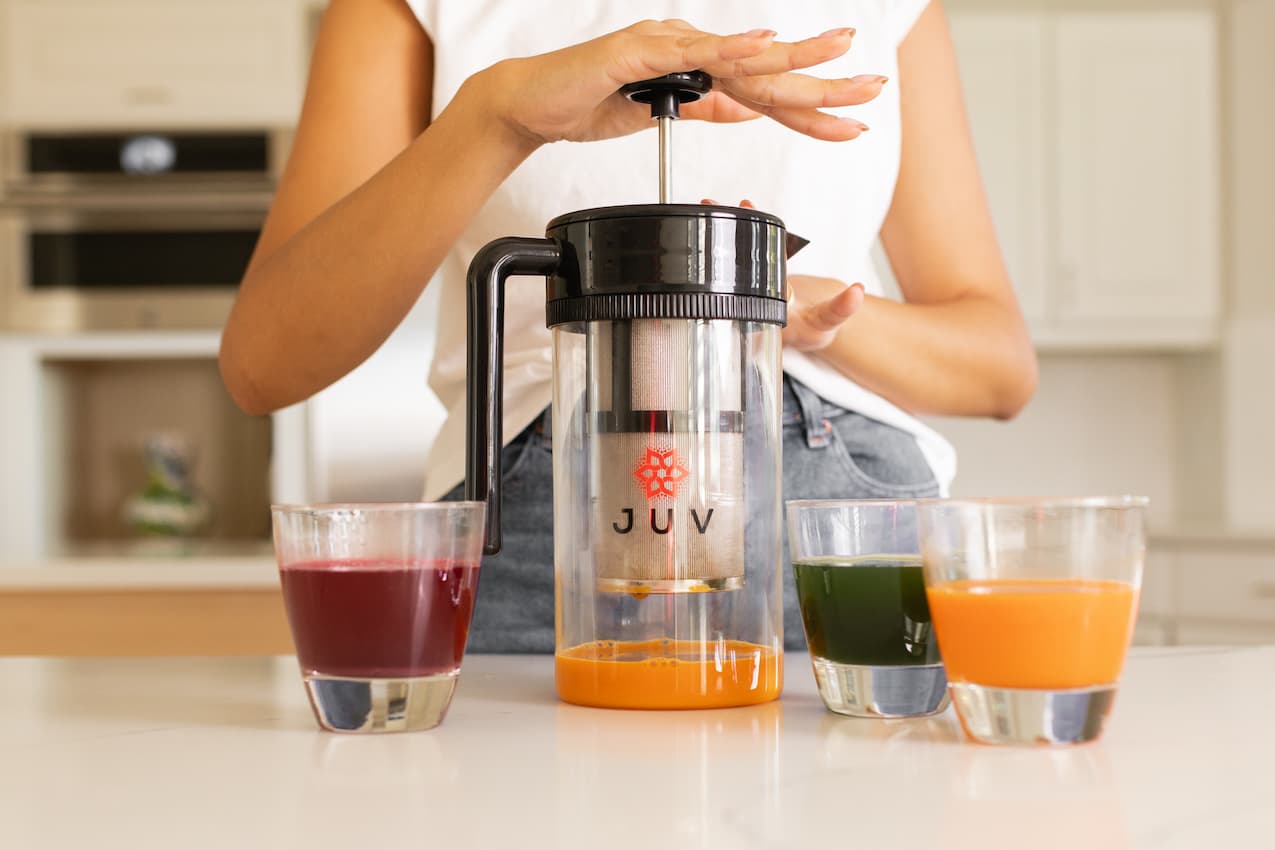JUICING VS BLENDING: WHAT OTHER GUIDES DON'T TELL YOU
Overview
What is the difference between juicing with a blender or a juicer? Should I use a blender or a juicer?
The short answer is, it depends. It depends on what your goals are and what you are trying to optimize for. There's a lot of confusion in the market. And we want to clear it up. Spoiler alert: A blender (with a simple added step) might be your answer.
In this post we'll cover the following:
1. What is juicing
2. Juicing with a traditional juicer
3. Blending (and juicing with a blender)
4. Misconceptions with blender juicing
5. Recommendations to approaching juicing
1. WHAT IS JUICING
Juicing is the process of extracting juice from vegetables and fruits. The juice is packed with nutrients for your body to absorb as effectively as possible.
2. JUICING WITH A TRADITIONAL JUICER
Juicers are single purposed specialized machines that only make juice. Juicers in the market range in price and function depending on the type you go with. There are two types of juicers on the market:
- Masticating juicers use an auger to compact and the vegetables into smaller pieces before squeezing the juice out. The auger spins very, very, very slowly squeezing out the juice. Think of a sloth. It's the reason masticating juicers get the name "slow juicers".
- Centrifugal juicers use a blade to shred the vegetables and, as the name implies, leverages centrifugal force to separate the fibers from the juice. In other words, the blade spins around at Tasmanian Daredevil speeds shredding the vegetables and centrifugal force pushes the pulp to the outside of the container leaving the juice behind. It's works just like your washing machine at the end of the cleaning cycle; spins really fast to wring out the water from clothes.
So, you're probably asking: what are the advantages and disadvantages to using a juicer? Well, glad ya asked.
Juicer Advantages
- Specialized machine to do a single task pretty well
- An all in one contraption to separate juice from pulp
- Left over pulp is contained within the pulp basket
Juicer Disadvantages
- Juicing machines can be expensive ($150 -$400)
- Only juices one vegetable at a time, so it can take a lot of time (better queue up your Netflix). The key here is it can be time commitment heavy
- Lots of intricate parts that are hard to clean
- They are usually too big to leave on a countertop, so require additional cabinet space
3. BLENDING (AND JUICING WITH A BLENDER)
Blenders functionally work by spinning a blade around, and as the name implies, mixes the contents together into a uniform substance. Blenders are a staple item in many kitchens since it's multi-purposed. Blenders can do everything from mixing soups, sauces, and making your favorite smoothie. But, blenders can actually also make juice! Cut down your veggies a bit and use a little water (exact amount will depend on your blender).
The nay-sayers
Now, this is where the nay-sayers will tell you, "you can't possibly use a blender to juice". They will tell you blenders don't separate the pulp and therefore it's more of a smoothie than a juice. And smoothies are digested slower releasing the benefits to your body much slower. But, juicers on the other hand, well, since they remove the pulp, their the big bad machine on the market.
And now, a dose of reality
This is where we need to take a step back. Most of the juicers on the market are centrifugal juicers which effectively shred the veggies and fruits. Yep, they shred. So, how is this much different than a blender? Blenders fine cut, effectively accomplishing the same thing. Think of it this way: what's the difference between grating garlic and pureeing garlic? One is finer than the other, but it's still garlic broken down.
Juicers, as discussed above, have a mechanism to separate the juice from pulp built in. Notice the key phrase here: built in. What's to say you couldn't blend your veggies and then use another device to filter out the pulp? Sieves or nut milk bags could do the trick. But, if you're looking for a mess free and hassle free option, give our JUV Press a shot.
Blending Advantages
- A kitchen staple you likely already own
- Blending is quick and efficient (just like smoothies!)
- Avoid buying a new expensive machine that takes up cabinet space
Blender Disadvantages
- Requires chopping down the veggies a little
- No "built in" filter to remove pulp
4. Misconceptions of Blender Juicing
So you can better evaluate whether blender juicing is for you, we need to set the record straight first. Below we'll cover misconceptions of blender juicing.- Blenders kill nutrients: This is a misnomer. Blenders aren’t to be blamed here. The longer any chopped, grinder, crushed, juiced or blended vegetable or fruit is exposed to oxygen, themore it will lose its nutritional benefit. As for “high speeds” killing nutrients, well, a lotof juicers on the market use high speeds to extract juice too (the centrifugal juicers). And besides, your blended green smoothie or blended butternut squash soup still has its nutritional benefit, doesn’t it?
- Water dilutes the juice: Sure, maybe it does a little. But, we're not taking about an exorbitant amount. It's just enough to get your ingredients blended. You're in control and can add more or less as needed. Besides, it's not like water is bad for ya 🙂. Also, it could help neutralize any glucose spikes if your juicing recipe is on the sweet side.
5. So, what should your approach be?
If you already have a PH.D in juicing, then, by all means, go for it and get a juicer. In our experience, juicing with a juicer is a big commitment. Juicing requires setup time, prep time, juicing time and clean up time. That's a lot of time! If you've got the time and motivation, then by all means, go for it. Get that juicer and start juicing today!!
But, if you are anything like us, you have a super busy lifestyle and not much wiggle room. We're not willing to sacrifice a healthy lifestyle only because our lifestyle is busy. So, we opt for the blender with our JUV Press to filter out the pulp.
It's also a great alternative if you are just starting out too. Think of it this way: would you go to the advance yoga for your first class? Good chance if you went from 0 to 100 you'd be discouraged. Same logic applies to juicing. Keep it simple. So, why not start out with a blender! Prove to yourself you can continue the habit and once you are ready, you could always upgrade to that juicer if that's what you're after.
But, until then, happy blender juicing!


